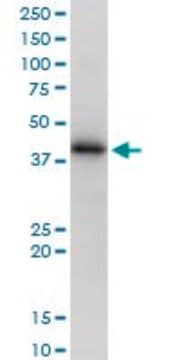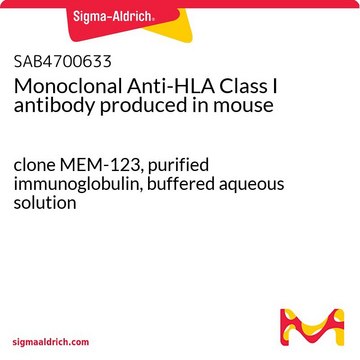SAB4700639
Monoclonal Anti-HLA Class I-FITC antibody produced in mouse
clone W6/32, purified immunoglobulin, buffered aqueous solution
About This Item
Polecane produkty
pochodzenie biologiczne
mouse
białko sprzężone
FITC conjugate
forma przeciwciała
purified immunoglobulin
rodzaj przeciwciała
primary antibodies
klon
W6/32, monoclonal
Postać
buffered aqueous solution
reaktywność gatunkowa
human
stężenie
1 mg/mL
metody
flow cytometry: suitable
izotyp
IgG2a
numer dostępu NCBI
numer dostępu UniProt
Warunki transportu
wet ice
temp. przechowywania
2-8°C
docelowa modyfikacja potranslacyjna
unmodified
informacje o genach
human ... HLA-A(3105) , HLA-B(3106) , HLA-C(3107)
Opis ogólny
The previously assigned protein identifier P01891 has been merged into P04439. Full details can be found on the UniProt database.
Immunogen
Zastosowanie
Cechy i korzyści
Postać fizyczna
Oświadczenie o zrzeczeniu się odpowiedzialności
Nie możesz znaleźć właściwego produktu?
Wypróbuj nasz Narzędzie selektora produktów.
Kod klasy składowania
10 - Combustible liquids
Temperatura zapłonu (°F)
Not applicable
Temperatura zapłonu (°C)
Not applicable
Certyfikaty analizy (CoA)
Poszukaj Certyfikaty analizy (CoA), wpisując numer partii/serii produktów. Numery serii i partii można znaleźć na etykiecie produktu po słowach „seria” lub „partia”.
Masz już ten produkt?
Dokumenty związane z niedawno zakupionymi produktami zostały zamieszczone w Bibliotece dokumentów.
Nasz zespół naukowców ma doświadczenie we wszystkich obszarach badań, w tym w naukach przyrodniczych, materiałoznawstwie, syntezie chemicznej, chromatografii, analityce i wielu innych dziedzinach.
Skontaktuj się z zespołem ds. pomocy technicznej






